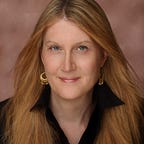The Courage to Show Up
On acknowledging privilege; on shame and guilt; on finding joy. How black and white people can learn to talk to each other.
“Some people live to see other people fail, and that’s sad,” the young man wrote. “Find some joy, folks.”
He is DeRay McKesson, civil rights activist, a force in the Black Lives Matter movement, and the founder of Campaign Zero, an initiative to end police violence.
“That’s painfully true,” the older woman tweeted in response. “I guess joy just takes more vulnerability than cruelty.”
She’s Brene Brown, research professor at the University of Houston, a social worker and author.
That initial Twitter exchange, which took place in August of 2016, swiftly evolved into a complex (and viral) conversation about race, vulnerability and privilege between two strangers: a young black man, a middle-aged white woman.
On February first of this year — the first day of Black History Month — they met in person for the first time in the nave of the Riverside Church, on the exact spot where 50 years earlier the Rev. Dr. Martin Luther King, Jr. had delivered his “Beyond Vietnam: A Time to Break Silence” speech. 2100 audience members listened in, along with over 10,000 others streaming the event live. The evening, called “The Courage to Show Up,” addressed the emotionally charged — and necessary — question: can white and black people learn how to talk to each other in the current atmosphere of distrust? More importantly, how can we learn how to listen — really listen — to one another?
Here are a few takeaways from this remarkable evening:
• Pessimism is seductive. Online, and in real life, the easiest — and frequently, the most obvious — response to the world we now live in is cynicism. It’s not hard to look around and find cause for pessimism: there are times when it’s all we can do not to stare at the television, or our devices, with an expression of slack-jawed despair. Tearing other people down has become our default mode — whether it’s because we believe that others’ actions are evil, or perhaps just because we feel they are trying to do good ineptly. “Feeling joy,” said Brown, “demands vulnerability. Pessimism is safe.” But how brave, she asked, is it to be cynical? Is not holding joy in the face of despair an act of courage?
• People who have privilege are often blind to it. The very word “privilege” triggers defensiveness among white people — and conversations about privilege can swiftly morph into a speech about striving and hard work, about how, in the words of Richard Nixon, “I worked for every penny I’ve got.” White people discount the role that whiteness may have played in their success. It is deeply awkward to admit that one’s own hard work — as noble or innovative as it may have been — was not the only element in one’s success story. But how do we get people to see a thing that is invisible to them? How do we get people to participate in a process that can feel like an invitation to shame?
• Shame and guilt are different things. Guilt means “I did something bad.” Shame means “I am something bad.” When confronted with evidence of racism’s pervasion, white people are swift to note that they themselves, for instance, never owned any slaves, seeing this as proof that, as our President claims, “I am the least racist person you will ever meet.”
But white people can (and must) accept their complicity in the system of injustice that slavery engendered. And we can (and must) also understand that we can work to undo that injustice. White America may be guilty of the original sin of slavery, but the proper response to this legacy is not shame, but engagement, and work, and a dedication to creating change.
• The antidote to shame is empathy. When people — white and black — speak of their pain or struggle, the proper response is to listen respectfully. “We need to ask better questions,” Brown said, “and to spend more time listening than talking.” This, instead of swiftly reacting with dismissal, or argument, or defensiveness.
• And finally, shame is not a tool for justice. The rage that so many of us — black and white — feel right now is a great catalyst for change, but, as Brown said, “it makes for a lousy life companion.” But the opposite of rage — joy — is hard to sustain, not only because the world around us is so abundant with injustice, but also because to be joyful means, in the same moment, to fear its loss. “We’re fighting not only for the absence of oppression,” Mckesson observed, “but also for the presence of justice and joy.”
The conversation, originally slated for an hour and a half, went on for nearly two — and even after the event, there were Mckesson and Brown still on stage talking quietly to each other. It struck me, as I headed out into the cold night, how incredibly thirsty we are for these conversations, how terribly frustrated we are that we have lost our ability to understand one another.
But we can do it. How? By acknowledging privilege; by finding the courage to express our joy, in all its vulnerability; and by cultivating the skill to listen with the same passion with which we hope to be heard.
